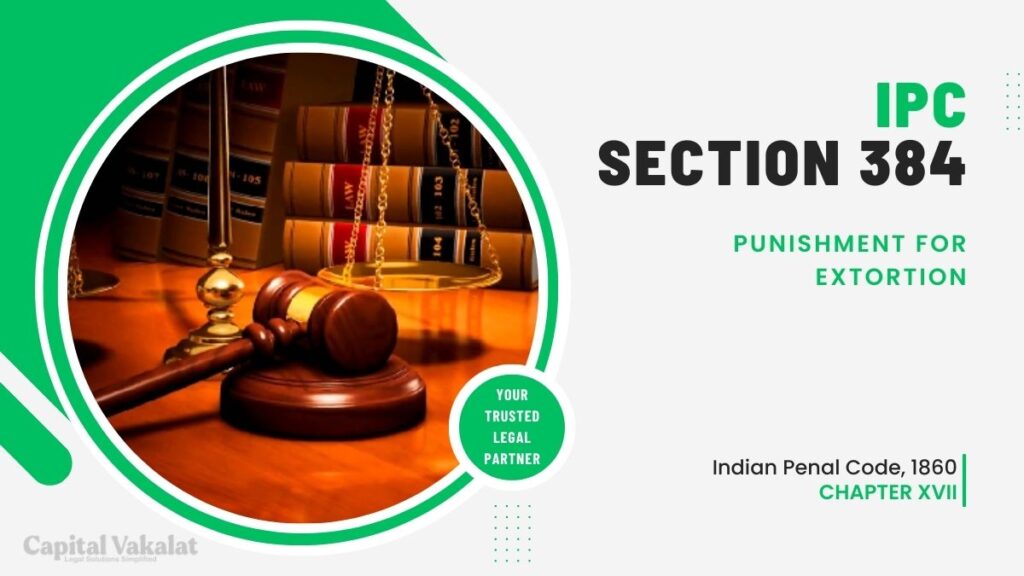Extortion, as defined under Section 384 of the Indian Penal Code (IPC), is a grave offense that encompasses the act of obtaining something, especially money, through force or threats. This article delves into the intricacies of Section 384 IPC, shedding light on its elements, punishments, case studies, and the broader societal impact of extortion.

Understanding Section 384 IPC is crucial in navigating the legal landscape surrounding extortion. This section specifically deals with the offense of extortion and outlines the legal consequences for those found guilty. In essence, extortion involves compelling someone to do something against their will, usually through threats or intimidation.
Elements of Section 384 IPC
Act of Extortion
At its core, extortion involves the act of obtaining something, whether it be money, property, or services, by using force or threats. The offender aims to coerce the victim into compliance, creating a situation where refusal seems untenable.
Intention to Cause Fear
For an act to qualify as extortion under Section 384 IPC, there must be a clear intention to instill fear in the victim. The psychological impact of threats is a key component in establishing the criminality of the act.
The Role of Threat or Injury
Extortion often relies on the use of threats or actual harm to compel the victim. The presence of a credible threat or the infliction of injury strengthens the case against the perpetrator.
Punishments under Section 384 IPC
The legal consequences for extortion are severe, reflecting the gravity of the offense. Those found guilty under Section 384 IPC can face imprisonment, a term that varies based on the circumstances of the case, and may also be subjected to fines.
Imprisonment serves as a deterrent, emphasizing society’s intolerance for such coercive and criminal behavior. The fines imposed act as both punishment and a means of compensating the victim for the damages suffered.
Case Studies
Examining real-life examples of extortion cases provides valuable insights into the dynamics of these offenses. In recent years, there have been cases where individuals or organized groups have attempted to extort money from businesses, public figures, and even ordinary citizens.
Legal Outcomes and Implications
Analyzing the legal outcomes of these cases allows us to understand how the courts interpret and apply Section 384 IPC. The implications of these decisions set precedents for future cases, shaping the legal landscape surrounding extortion.
Differences between Extortion and Other Offenses
It is crucial to distinguish extortion from related offenses such as robbery and blackmail. While these crimes share similarities, they differ in their legal definitions and implications.
Understanding the Nuances in Legal Terms
Robbery involves the use of force or threat during the act of stealing, whereas extortion focuses on coercion for personal gain. Blackmail, on the other hand, typically involves the threat of revealing damaging information unless a demand is met.
Historical Perspective
To fully grasp the significance of Section 384 IPC, it is essential to explore the historical evolution of extortion laws in India. Understanding how these laws have changed over time provides context for their current form and application.
Changes and Amendments Over the Years
The legal framework surrounding extortion has undergone changes and amendments to adapt to the evolving nature of criminal activities. Exploring these changes sheds light on the legislative intent behind extortion laws.
Notable Court Decisions
Landmark judgments related to Section 384 IPC offer valuable insights into the legal interpretations and precedents established by the judiciary. These decisions contribute to the development of a robust legal framework for tackling extortion cases.
Legal Interpretations and Precedents
Courts play a pivotal role in shaping the understanding of extortion laws. Legal interpretations and precedents set by higher courts guide lower courts and law enforcement agencies in addressing similar cases.
Prevention and Reporting
Preventing extortion requires a combination of awareness, vigilance, and swift reporting. Individuals and businesses should take proactive measures to minimize the risk of falling victim to extortion.
Reporting Procedures and Legal Assistance
Understanding the procedures for reporting extortion is crucial for ensuring a prompt and effective response. Legal assistance is instrumental in navigating the complexities of the legal process and seeking justice.
Social Impact of Extortion
The repercussions of extortion extend beyond the immediate victims, affecting society at large. The psychological and economic consequences of extortion can leave lasting scars on individuals and communities.
Addressing the Psychological and Economic Consequences
The psychological trauma inflicted on victims of extortion is often overlooked. Additionally, the economic impact can be significant, especially for businesses and individuals who may face financial ruin as a result of extortion.
Future Outlook
As society evolves, so too must the legal framework governing extortion. Exploring possible amendments and improvements to Section 384 IPC is essential for ensuring the continued effectiveness of anti-extortion laws.
The Role of Technology in Combating Extortion
Advancements in technology present both challenges and opportunities in combating extortion. The use of digital platforms for extortion calls for innovative approaches in investigation and prevention.
Conclusion
In conclusion, Section 384 IPC plays a vital role in addressing the menace of extortion in society. Understanding its elements, punishments, and the broader context in which it operates is crucial for individuals, businesses, and law enforcement agencies alike.
Frequently Asked Questions
Are there specific industries more prone to extortion attempts?
While extortion can target any industry, sectors with high financial stakes, such as finance and entertainment, may be more susceptible.
Can a threat be considered extortion even if no money is demanded?
Yes, the act of coercion itself, irrespective of the demand for money, can constitute extortion under Section 384 IPC.
What is the statute of limitations for prosecuting extortion cases?
The statute of limitations for prosecuting extortion cases varies, and legal advice should be sought to determine the applicable timeframe.
How can technology be leveraged to combat extortion in the digital age?
Embracing technological solutions, such as advanced cybersecurity measures and digital forensics, can aid in combating extortion in the digital age.